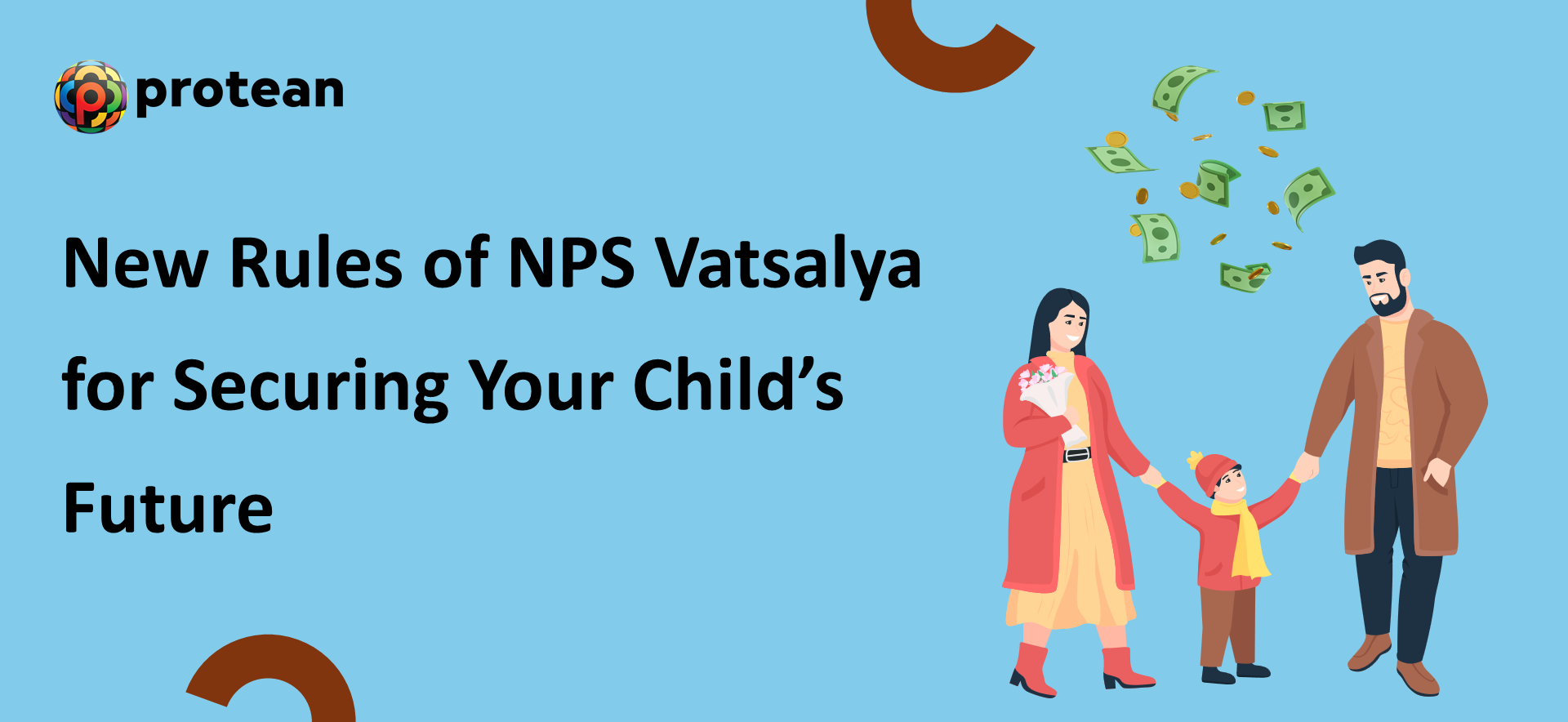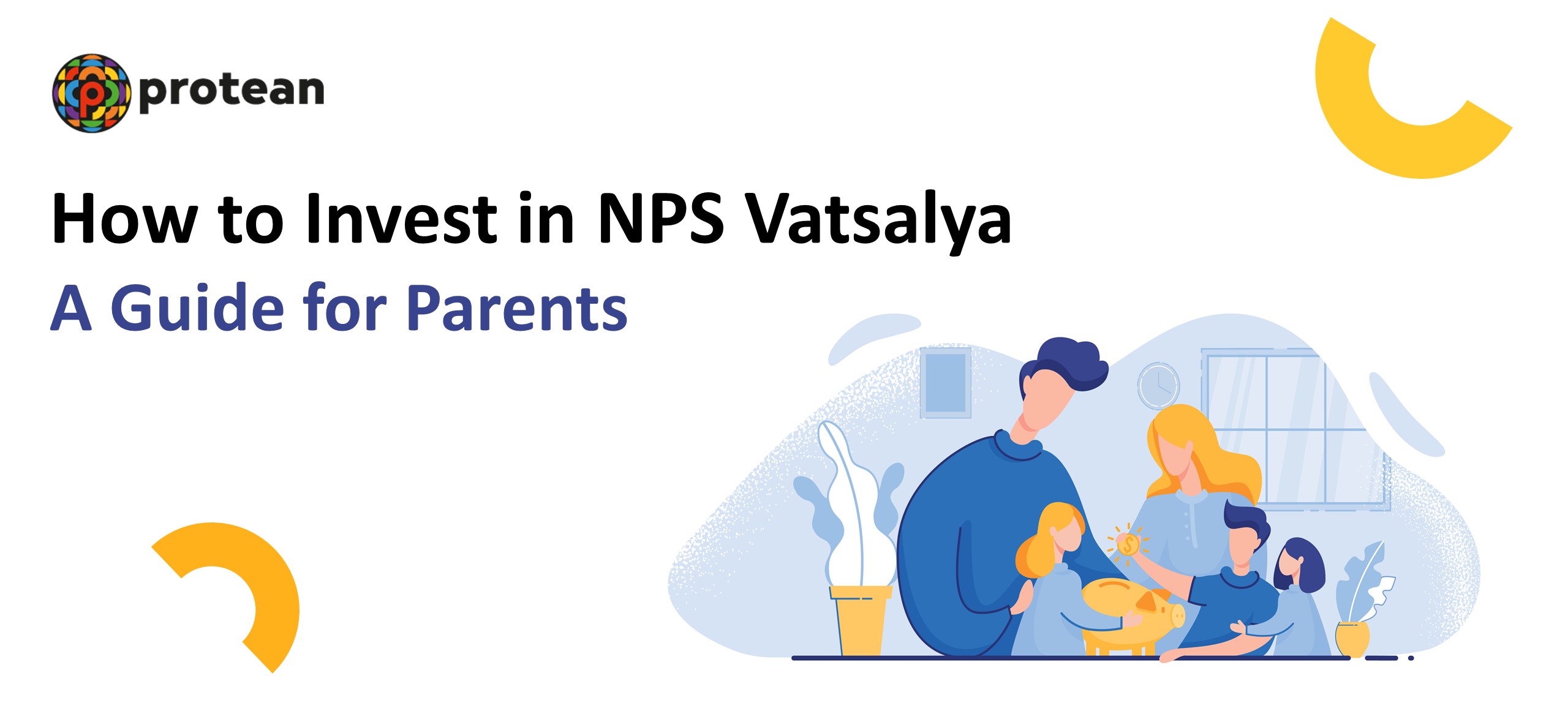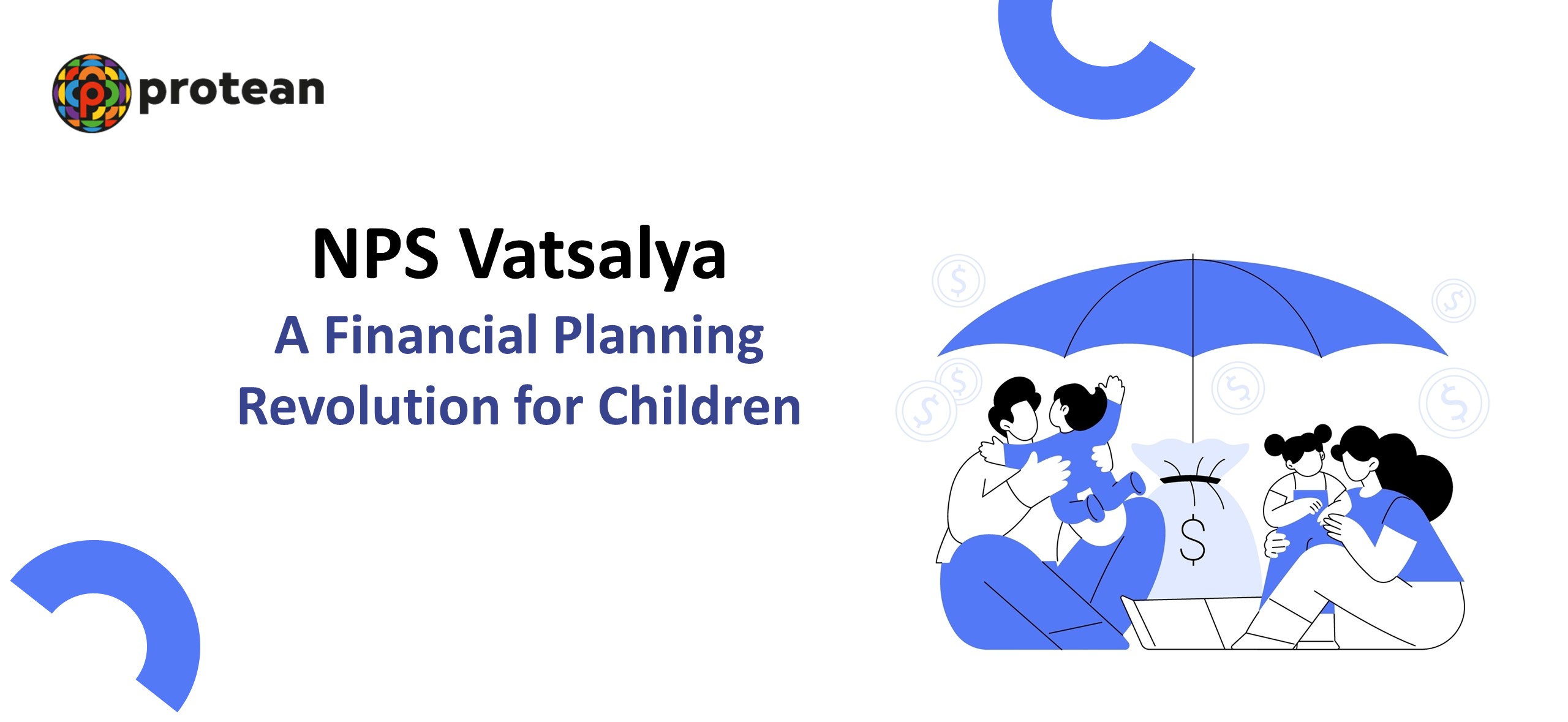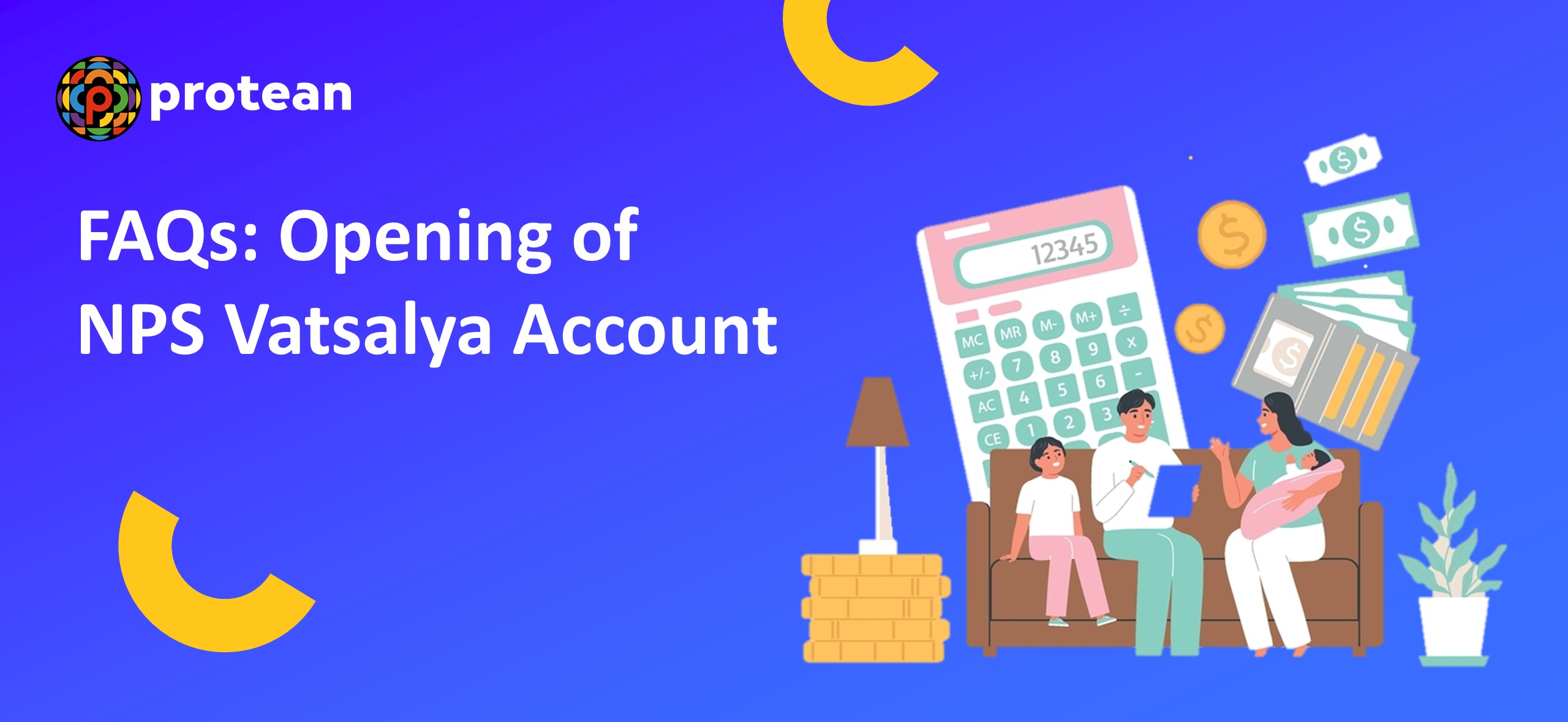Blogs
NPS Vatsalya Scheme: New Rules for Securing Your Child’s Future
Every parent dreams of securing their child’s financial future, ensuring they have the independence and stability to thrive in adulthood. While college funds and savings accounts are common tools, the ultimate goal—creating a long-term, protected wealth foundation—requires a specialized instrument. This is the vision behind the NPS Vatsalya Scheme.
This dedicated pension plan for minors marks as an outstanding shift in long-term financial nurturing. It allows parents and legal guardians to plant the seed of a future retirement corpus and financial discipline for their child, leveraging the immense power of compounding over decades. Parents gain a unique, tax-efficient pathway to secure their child’s financial security by understanding the NPS Vatsalya rules.
Let's explore the NPS Vatsalya initiative, its features, and how it benefits both parents and their children compared to the general NPS framework.
NPS Vatsalya Before the Amendments
NPS Vatsalya was primarily focused to promote early financial discipline and long-term compounding through investments under the National Pension System framework for minors. Here is a brief overview of its initial structure and features that remain foundational to the scheme:
Eligibility and Operation
The proposed scheme is expected to be available to Indian citizens below 18 years of age (including NRIs and OCIs as well), operated under the guardianship framework.
- Subscriber and Guardian: The account is opened in the name of the minor (the subscriber), who is the sole beneficiary. However, the account is exclusively operated by the natural or legal guardian until the minor attains 18 years of age.
- Unique PRAN: A unique Permanent Retirement Account Number (PRAN) is issued in the minor’s name, ensuring portability and continuity.
Contribution Structure
The scheme was designed to be highly accessible, encouraging continuous, systematic contributions.
- Minimum Contribution: The minimum amount required to open the account is ₹1,000. Subsequent minimum annual contribution is also ₹1,000.
- Maximum Contribution: Crucially, there is no upper limit on the maximum amount that can be contributed annually, offering full flexibility based on the parent's financial capacity.
Account Management & Custody
- A parent or legal guardian acts as custodian of the account, overseeing all contributions and investment decisions until the subscriber reaches 18. This is supported by PFRDA’s framework, ensuring the guardian exclusively operates and manages the account in the best interest of the minor.
- Guardians have the option to select both the Pension Fund (PF) and Central Recordkeeping Agency (CRA) from registered PFRDA entities, similar to the choices available under the standard NPS models.
Partial Withdrawal (Pre-18 Years)
The partial withdrawal rules for NPS Vatsalya before the latest amendment allowed guardians to partially withdraw funds under specific conditions before the minor turned 18 years of age. The key features of the old partial withdrawal rules were:
- Partial withdrawals were permitted only after a lock-in period of 3 years from the account opening date.
- Up to 25% of the total contributions (excluding returns) could be withdrawn.
- Withdrawals could be made for specific reasons such as the minor’s higher education, treatment of specified illnesses, or disability exceeding 75%.
- A maximum of three partial withdrawals were allowed during the entire period until the minor attained 18 years.
- Withdrawals were allowed on a declaration basis.
- Upon reaching 18 years, the NPS Vatsalya account could be converted into a regular NPS Tier I account
Lack of Dedicated Tax Benefits
Under the initial framework, the contributions made by parents to the NPS Vatsalya account were generally not eligible for a specific tax deduction separate from their own NPS contributions. This was a point of concern for many potential subscribers, as it meant the primary incentive for investment was solely the compounding return, not tax savings—a key driver for most retirement schemes in India.
NPS Vatsalya: Investment Choices and Management
NPS Vatsalya allows a guardian to manage the minor’s account using either the Active or Auto Choice investment option, consistent with regular NPS schemes. Each option caters to varying financial goals and degrees of involvement required from the guardian.
Auto Choice
For guardians who prefer age-appropriate risk calibration, the Auto Choice route offers three Life Cycle Fund variants:
- Aggressive (LC-75): Prioritizes higher equity (up to 75%), adjusting toward safety as the minor ages.
- Moderate (LC-50): Separates assets evenly between equity and debt (50% equity).
- Conservative (LC-25): Starts with a quarter in equity (25%) and transitions gradually into more secure investments over time.
- The equity share in each Auto Choice option is programmed to reduce as the minor approach’s adulthood, mirroring standard NPS lifecycle management.
Active Choice
Guardians wanting hands-on control can opt for Active Choice, which enables direct specification of asset allocation within regulatory limits:
- Equity (E): Up to 75% of contributions
- Corporate Debt (C): Up to 100%
- Government Securities (G): Up to 100%
- Alternative Assets (A): Capped at 5%
This arrangement mirrors the approach in the NPS All Citizen Model, giving flexibility to tailor the portfolio according to changing priorities or risk appetite.
The New NPS Vatsalya Rules
The primary provisions relate to tax benefits for contributions and clarification on withdrawal taxability.
New Tax Deduction for Contributions: Section 80CCD(1B)
This is the most impactful change for parents and guardians:
- Deduction Eligibility: Contributions made by a parent or guardian to a minor’s NPS Vatsalya account qualify for the existing deduction under Section 80CCD(1B), subject to overall limits.
- The ₹50,000 Advantage: The deduction is allowed up to a maximum of ₹50,000 under Section 80CCD(1B) of the Income Tax Act.
- Important Caveat: This deduction is not an additional ₹50,000 benefit. It is shared with the existing ₹50,000 deduction available for self-contribution to a regular NPS Tier-I account. A parent can claim this deduction by contributing to either their own NPS or their child’s NPS Vatsalya account, or a combination of both, up to the overall limit of ₹50,000 (over and above the ₹1.5 lakh limit under Section 80C).
- Applicability: This tax deduction is available exclusively to individuals opting for the Old Tax Regime.
The introduction of this tax benefit positions the NPS Vatsalya Scheme as a much more attractive investment, allowing parents to simultaneously reduce their current tax liability while securing a substantial, long-term fund for their children.
Tax Exemption on Partial Withdrawals (New Section 10(12BA))
Earlier, withdrawals from a minor’s NPS account could be taxed in the hands of the parent under clubbing provisions, with limited clarity on the taxability of the growth portion. The new rule provides clarity:
- Exemption: Partial withdrawals of up to 25% of own contributions for specified purposes are permitted under existing NPS regulations. However, no separate exemption under Section 10(12BA) currently exists; taxation depends on general NPS provisions.
- Benefit: This amendment ensures that parents can access funds for genuine emergencies like higher education or specified medical treatment without facing an immediate tax burden on the growth component of the withdrawn amount.
Clarity on Exit and Lump-Sum Taxability
The tax treatment upon exit or closure of the account at age 18 has been clarified under the new rules of NPS Vatsalya:
- General Rule (Section 10(12A)): Upon conversion to the NPS Tier-I account or exit at age 18, up to 60% of the accumulated corpus received as a lump sum is tax-exempt. The remaining 40% must be used to purchase an annuity (pension plan), the income from which is taxed as per the individual's slab rate.
- Corpus Threshold: If the accumulated corpus is less than or equal to ₹2.5 lakh, the subscriber can withdraw the entire amount as a lump sum, which is 100% tax-exempt.
- Death of Minor: In case of the minor subscriber’s death, the corpus is payable to the guardian or nominee. While PFRDA permits full withdrawal, tax exemption would follow general NPS provisions.
The new NPS Vatsalya rules provide a necessary layer of tax security and incentive, making it a powerful vehicle that addresses both current tax savings and future financial planning needs.
NPS Vatsalya: Old vs. New Rules
This comparison focuses primarily on the significant taxation changes that impact the contributor (parent/guardian), as the core operational aspects remain largely the same.
| Feature | Old Rules | New Rules | Significance of Change |
|---|---|---|---|
| Tax Deduction on Contribution (Parent/Guardian) | None explicitly dedicated. Contributions were not eligible for a specific deduction under Section 80CCD(1B) for the child's account. | Up to ₹50,000 Deduction under Section 80CCD(1B) is allowed for the contributions made by the parent/guardian. | Game-Changer: Provides a dual benefit of tax savings for the parent (under Old Regime) and long-term savings for the child. |
| Tax Regime Applicability | Not applicable, as there was no dedicated tax benefit. | Available only under the Old Tax Regime. It is not available to taxpayers opting for the New Tax Regime. | Encourages taxpayers on the Old Regime to utilize this scheme for additional tax savings beyond the ₹1.5 Lakh limit. |
| Tax on Income from Partial Withdrawal | Tax treatment of partial withdrawals was unclear and might have been subject to clubbing provisions with parent's income. | Partial withdrawals up to 25% for specified reasons are fully tax exempt under Section 10(12BA), providing tax relief. | Provides clear tax relief during unforeseen emergencies like higher education or critical illness. |
| Tax on Corpus on Minor's Death | Not explicitly stated, though generally not considered income. | Fully Tax Exempt. The entire corpus paid to the guardian upon the minor's death is not included in the parent's/guardian’s taxable income. | Provides clarity and financial assurance to the family during a tragic event. |
| Maximum Contribution | No upper limit (Remains the same). | No upper limit (Remains the same). | Provides unlimited scope for wealth creation regardless of tax benefit ceiling. |
| Mandatory Conversion at 18 | Seamless shift to NPS Tier-I Account with mandatory fresh KYC within 3 months (Remains the same). | Seamless shift to NPS Tier-I Account with mandatory fresh KYC within 3 months (Remains the same). | Ensures continuous, uninterrupted retirement planning into adulthood. |
| Also Read: Gift Your Child Financial Security with NPS Vatsalya |
Securing the Financial Future of Parents and Children
The updated framework dramatically enhances the value proposition of the NPS Vatsalya Scheme for families. It successfully intertwines parental tax planning with the child’s long-term wealth creation.
Leveraging the Power of Compounding and Time
The biggest benefit of the scheme remains the principle of starting early. A minor enrolled in the scheme has up to 18 years to benefit from compounding, often in high-growth assets like equity (via the Active Choice option). The earlier the parent starts, the smaller the contributions needed to build a large corpus. The new tax deduction amplifies this effect by reducing the effective cost of the contribution for the parent.
Retirement and Contingency
The NPS Vatsalya scheme uniquely serves a dual purpose:
- Retirement Foundation: By the time the child turns 18, they inherit a substantial, debt-free, long-term corpus, and the account seamlessly converts to a regular NPS Tier-1 account under the All Citizen Model, giving them a monumental head start on their own retirement planning—a concept entirely absent in most other child plans.
- Major Life Contingency: The provision for partial withdrawal for higher education or critical medical treatment acts as a financial safety net, ensuring funds are available when needed most during the child’s formative years, without compromising the long-term pension wealth too severely.
How NPS Vatsalya Promotes Financial Discipline
Unlike pure savings accounts, the structured nature of NPS Vatsalya, with its lock-in period and exit norms, inherently educates both parents and, eventually, the child about long-term investing, disciplined saving, and the importance of having a retirement goal. Upon turning 18, the child assumes full account management responsibility, with the NPS Vatsalya account transitioning seamlessly into the regular NPS Tier-I (All Citizen) model, subject to fresh KYC within three months.
Step-by-Step Guide and Continuation at 18 with NPS Vatsalya
The procedure to open and operate the account is straightforward:
Account Opening Process
- Eligibility Check: Ensure the child is a minor Indian citizen (under 18 years).
- Guardian KYC: The natural or legal guardian must submit their identity and address proof (Aadhaar, PAN, etc.).
- Minor’s DOB Proof: Documents like the birth certificate, school certificate, or minor’s passport are required.
- Registration: The account can be opened online through the eNPS platform or via Points of Presence (PoPs) registered with PFRDA (major banks, etc.), making the process widely accessible.
- Initial Contribution: Deposit the minimum opening contribution of ₹1,000.
- PRAN Generation: A unique PRAN is generated in the minor’s name.
The Seamless Transition at Age 18
The transition is a critical feature of the NPS Vatsalya rules.
- When the minor attains the age of 18, the account does not close; it continues to be operational.
- It automatically shifts into the standard NPS Tier-I (All Citizen) Account
- Mandatory Step: The new adult subscriber must complete a fresh Know Your Customer (KYC) process within three months of turning 18 to continue contributions and manage the account independently.
- Post-transition, all the features, benefits, and exit norms applicable to the regular NPS Tier-I account come into effect, allowing the individual to continue saving for their retirement until age 60 or 75, as applicable.
To Conclude
The update for the NPS Vatsalya rules, particularly the dedicated tax relief, have removed the main hesitation point for many parents. The NPS Vatsalya scheme is positioned to become an indispensable component of comprehensive child financial planning, truly helping parents and their children secure a prosperous and pensioned future by offering a tax-efficient route to tap into the long-term potential of the capital markets.
So, what are you waiting for? Give your child the lifelong gift of financial security and a powerful retirement head start with NPS Vatsalya.
Frequently Asked Questions (FAQs) on NPS Vatsalya
Q1: Who is eligible to open an NPS Vatsalya account?
Any minor Indian citizen (under 18) is eligible to be the subscriber, though the account must be opened and operated solely by their parent or legal guardian.
Q2: Are there any tax benefits under the new rules of NPS Vatsalya?
Yes, the parent/guardian can claim a deduction of up to ₹50,000 under Section 80CCD(1B) for contributions made to the NPS Vatsalya scheme. This is available only under the Old Tax Regime and is shared with their self-NPS contribution limit.
Q3: Can I make a withdrawal before my child turns 18?
Yes. Partial withdrawals of up to 25% of your contribution are allowed after a 3-year lock-in period, for specific purposes like higher education, or treatment of specified illnesses.
Q4: What is the tax implication of withdrawing the corpus at age 18?
At age 18, if the corpus is ₹2.5 lakh or less, the entire amount can be withdrawn tax-free. For corpora above ₹2.5 lakh, at least 80% must be used to purchase an annuity; the remaining up to 20% can be withdrawn as a lump sum tax-free. The annuity income is taxable when received.






